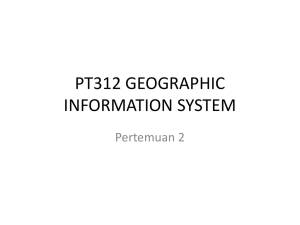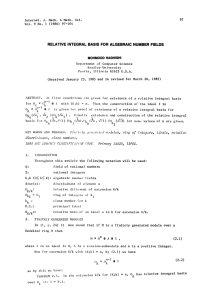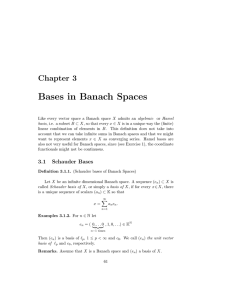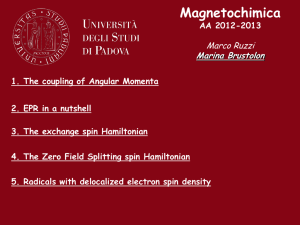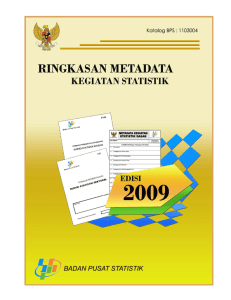Sistem Informasi Geografis
advertisement
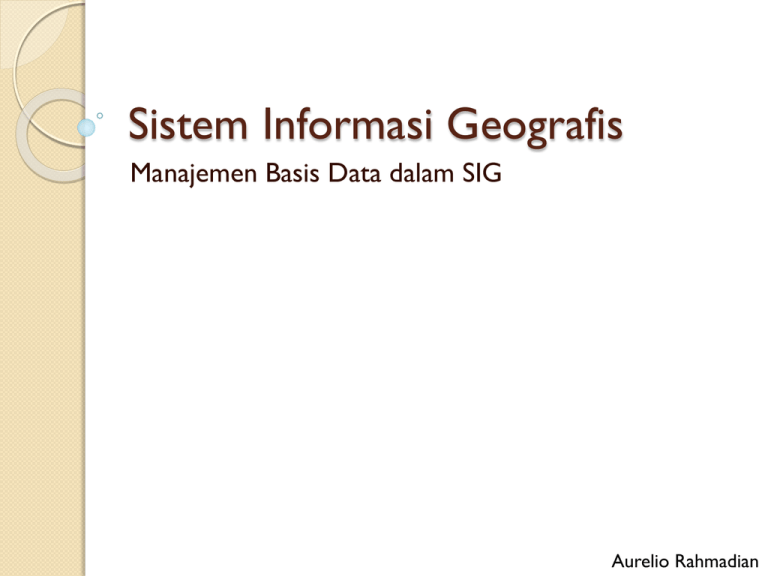
Sistem Informasi Geografis Manajemen Basis Data dalam SIG Aurelio Rahmadian Sistem Manajemen Basis Data SIG SIG merupakan perangkat pengelolaan basis data (DBMS = Data Base Management System) dimana interaksi dengan pemakai dilakukan dengan suatu sistem antar muka dan sistem query dan basis data dibangun untuk aplikasi multiuser. SIG merupakan perangkat analisis keruangan (spatial analysis) dengan kelebihan dapat mengelola data spasial dan data non-spasial sekaligus. Sistem Manajemen Basis Data SIG Syarat pengorganisasian data: Volum kecil dengan klasifikasi data yang baik; Penyajian yang akurat; Mudah dan cepat dalam pencarian kembali (data retrieval) dan penggabungan (proses komposit). Tipe Data Data lokasi: ◦ Koordinat lokasi ◦ Nama lokasi ◦ Lokasi topologi (letak relatif: sebelah kiri danau A, sebelah kanan pertokoan B) Data non-lokasi: ◦ Curah hujan ◦ Jumlah panen padi ◦ Terdiri dari variabel (tanah), kelas (alluvial), nilai luas (10 ha), jenis (pasir) Data dimensi waktu (temporal): ◦ Data non-lokasi di lokasi bersangkutan dapat berubah dengan waktu (misal: data curah hujan bulan Desember akan berbeda dengan bulan Juli) Desain Konseptual Data Model ◦ A data model is a formal specification for the entities, their attributes and all relationships between the entities for the GIS. ◦ The purpose of a data model is to make it possible for both user and GIS analyst agree on the data definitions which is represented completely rigorous and unambiguous fashion. Desain Konseptual Building Located on Resides Parcel Owned by Shelf Occupant Upper Slope Plateau Joe Jonesor Terrace Owner Simple Entity – Relationship (E-R) Diagram Entities represented as rectangles, relationship as diamonds and attributes as ellipses. Apex Co. Lower Deep Rise Slope Ocean Desain Konseptual E-R Model 1. Parts of E-R Model: • Entities; 3. Rules for identifying entities, relationships, and attributes: • A common noun corresponds • Relationships between entities; • Attributes of entities or relationships. to an entity type; • A transitive verb corresponds 2. Types of normal relationships: to a relationship type; • An adjective corresponds to • Belonging to; an attribute type. • Set and subset relationships; • Parent-child relationships; • Component parts of an object. Desain Konseptual Each entity and its attribute map into one or more relational tables. Area terbangun Bangunan Bangunan Bangunan Bangunan Rise kantor rumah sakit sekolah pertokoan Koordinat Letak Luas Milik Each relationship is a regular relationship executed by the relational database query system or a spatial relationship and if it is not a standard operation then the indicated operation which usually includes a complex computation need to be written (using Avenue Script/Macro Language). Desain Konseptual Metadata is “information about data”: (i) describe the characteristics of the data (entity and attributes) using its standard name, and (ii) provide information on its accuracy and its source and its archiving provision. Important functions of metadata: provide (i) a basic data description of a data set; (ii) information for data transfer / sharing; (iii) information for entries into clearinghouses to catalogue the availability of data. Metadata should serve as: (i) a documentation and data management tool; (ii) data definition, source documentation, management and updating, data archiving and retention requirement; (iii) information to support database description for spatial data clearinghouses. Desain Konseptual An example of metadata tables: 1. Organization Information Name of Organization Department Room/Suite# Number & Street Name City State Zip Code Shelf Phone Number Fax Number Upper Plateau Contact Person Slope or Extension Number Terrace E-mail Address Internet Address Comments 2. Reference Information Filename File Format Availability Cost File Internet Address Metadata Created By Date Metada Created Metadata Updated By Date Metadata Updated Metadata Standard Name Comments Lower Deep Rise Slope Ocean 5. Attribute Information Data Object Name Data Attribute Name Attribute Description Attribute Filename Code Set Name Code Set Description Measurement units Accuracy Description Comments Perencanaan DB The quality of information Information is stored in a database; Bad construction and data error will give Garbage instead of Geographic Information System; What kind of map projection will be used; What scale is the data; What is the coverage; How much attribution should be included; What is the attribute data format; What is the data reliability; How fast is it to be retrieved. Perencanaan DB Information required for database design: A complete list of data, properly defined and checked for validity and consistency (from the master data list, E-R data model, and metadata entries); A list of potential data source (maps, aerial photos, tabular files, digital files) cataloged and evaluated for accuracy and completeness (from available data survey); The list of functional capabilities required from the GIS (from needs assessment). Such as visualization, spatial analysis, statistical analysis and modeling. Perencanaan DB Entities, Attributes, and Spatial Object Plateau or Terrace Lower Deep Rise Slope Ocean Perencanaan DB Plan for data sharing Benefits of data sharing include: (i) the development of much larger database for far less cost; (ii) the development of more efficient interaction between public agencies; and (iii) all agencies shared the same up-to-date database / information. Database maintenance requires two efforts: ongoing user training (how to maintain the database) and user support (who will be responsible for updating which data). Perencanaan DB Designing the Database Most of databases in GIS software packages are based on the relational database model; Two choices of using data table: as much data in one table or small/compact data in one table; How you will represent the data: point, line, polygon, network, etc. Konstruksi DB Database construction/conversion is the process of building the digital database from the source data - maps and tabular files. The main emphasis is management of the activity and quality assurance / quality control of the converted data. Konstruksi DB Data Conversion ◦ Manual digitizing using a digitizing tablet and cursor tool (puck); ◦ Scanning (converts lines and text into series of pixels); ◦ Raster to Vector Conversion (convert series of pixels into series of (x,y) coordinates points), this facility is usually provided by a GIS software; ◦ Hybrid solution (overlaying vector format data with an image provides a powerful graphic display tool; Konstuksi DB • Map graphics represent all of the features (entities) on a map as points, lines, areas, or pixels; • Tabular databases contain the attribute information which describe the entities (building, parcel, etc.); • A common key (graphics data index) must be established between the map graphics and the tabular database records to create a link. Graphics Data Index Konstuksi DB Raster Data (pixels) Raster GIS Data Graphics Grid / Raster 1 1 1 1 2 2 1 1 1 2 2 2 2 2 2 1 1 2 1 3 3 3 3 2 3 3 3 3 3 3 3 3 3 3 3 3 Value Attribute Table Cell Value Real World Entity 1 Lake 2 Wooded 3 Built-up Konstuksi DB Vector GIS Data Vector GIS Data Vector GIS Polygon Layer 2 1 3 Polygon Attribute Table Polygon Numbet Identity Attribute 1 Lake 2 Wooded 3 Built-up Basis Data Relasional Basis Data relasional menggunakan tabel dua dimensi yang terdiri atas baris dan kolom untuk memberi gambaran sebuah berkas data. Basis Data Relasional MHS NPM Nama Alamat 10296832 Nurhayati Jakarta 10296126 Astuti Jakarta 31296500 Budi Depok 41296525 Prananingrum Bogor 50096487 Pipit Bekasi 21196353 Quraish Bogor Basis Data Relasional MKUL KDMK MTKULIAH SKS KK021 P. Basis Data 2 KD132 SIM 3 KU122 Pancasila 2 Basis Data Relasional NILAI NPM KDMK MID FINAL 10296832 KK021 60 75 10296126 KD132 70 90 31296500 KK021 55 40 41296525 KU122 90 80 21196353 KU122 75 75 50095487 KD132 80 0 10296832 KD132 40 30 Basis Data Relasional Keuntungan: ◦ Bentuknya sederhana ◦ Mudah melakukan berbagai operasi data Basis Data Relasional Sumber: Dinar D.A. Putranto, ‘Pendekatan Basisdata Berorientasi Obyek untuk Manajemen Tata Ruang Kota’, Disertasi Doktor, ITB, 2000. Hybrid & Integrated System Pengertian 1: Struktur data vektor dan struktur data raster dapat dipadukan pada suatu sistem, dengan melengkapi fasilitas konversi vektor ke raster dan raster ke vektor. Selain itu juga disediakan fungsi-fungsi untuk mengolah masingmasing struktur data Pengertian 2: Data SIG terdiri dari dua bentuk data: yaitu data grafis yang menyatakan entitas obyek dan data attribut. Data grafis yang terdiri dari data koordinat dan data topologi disimpan di berkas yang terpisah dari data atribut. Data atribut ditangani oleh database management system. Penggabungan kedua tipe data dilakukan melalui suatu kode identifikasi, misal kode identifikasi poligon, garis atau titik. Hal yang sama juga dapat dilakukan ‘linkage’ antara grid-cell modules dengan database management system. Pengertian 3: Operasional SIG secara keseluruhan yang terdiri dari SIG software, CAD software, Image Processing software, GPS software, Open-Source components, DBMS system Hybrid & Integrated System Hybrid & Integrated System

